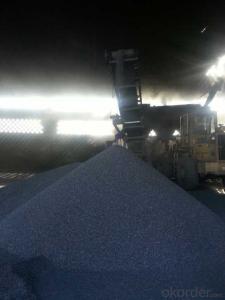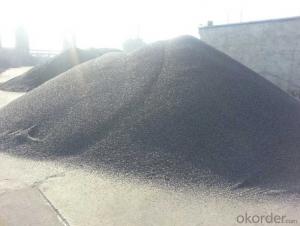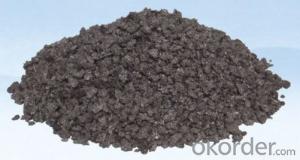Calcined Anthracite FC 80-90 for steel making
- Loading Port:
- Tianjin
- Payment Terms:
- TT OR LC
- Min Order Qty:
- 20 m.t.
- Supply Capability:
- 3000 m.t./month
OKorder Service Pledge
OKorder Financial Service
You Might Also Like
Packaging & Delivery
25kgs/50kgs/1ton per bag or as buyer's request
Specifications
Calcined Anthracite
Fixed carbon: 90%-95%
S: 0.5% max
Size: 0-3. 3-5.3-15 or as request
It used the high quality anthracite as raw materials through high temperature calcined at over 2000 by the DC electric calciner with results in eliminating the moisture and volatile matter from anthracite efficiently, improving the density and the electric conductivity and strengthening the mechanical strength and anti-oxidation. It has good characteristics with low ash, low resistvity, low sulphur, high carbon and high density. It is the best material for high quality carbon products.
Advantage and competitive of caclined anthracite:
1. strong supply capability
2. fast transportation
3. lower and reasonable price for your reference
4.low sulphur, low ash
5.fixed carbon:95% -90%
6..sulphur:lower than 0.3%
General Specification of Calcined Anthracite:
| FC | 80 | 83 | 85 | 88 | 90 |
| ASH | 16 | 14 | 13 | 10 | 8.5 |
| V.M. | 3 | 3 | 2 | 2 | 1.5 |
| S | 0.5 | 0.5 | 0.5 | 0.5 | 0.35 |
| MOISTURE | 2 | 2 | 1 | 1 | 0.5 |
Pictures

We are also strong at below materials, please contact us if you are interested in any of them:
Calcined Petroleum Coke
Carbon Electrode Paste
Carbon Electrode
- Q: What are the sources of carbon emissions?
- The sources of carbon emissions include burning fossil fuels (such as coal, oil, and natural gas) for electricity, transportation, and industrial processes, as well as deforestation and land-use changes.
- Q: What are the consequences of increased carbon emissions on urban areas?
- Increased carbon emissions have significant consequences on urban areas. One of the most notable impacts is the exacerbation of air pollution. Carbon emissions, particularly from vehicles and industrial activities, contribute to the release of harmful pollutants such as nitrogen oxides and particulate matter. These pollutants can lead to respiratory problems, exacerbate existing health conditions, and increase the risk of lung cancer and cardiovascular diseases among urban residents. Furthermore, increased carbon emissions contribute to the phenomenon of urban heat islands. Carbon dioxide and other greenhouse gases trap heat in the atmosphere, leading to rising temperatures in urban areas. This effect is particularly pronounced due to the abundance of concrete and asphalt surfaces that absorb and radiate heat. As a result, urban areas experience higher temperatures than surrounding rural areas, exacerbating the discomfort and health risks associated with heat stress, especially for vulnerable populations such as the elderly and those with limited access to cooling resources. The consequences of increased carbon emissions on urban areas also extend to the natural environment. Urban green spaces and ecosystems are negatively impacted as higher levels of carbon dioxide can disrupt plant growth and reduce biodiversity. This further exacerbates the loss of natural habitats and the degradation of urban ecosystems, leading to a decrease in the provision of ecosystem services such as air purification, temperature regulation, and stormwater management. In addition to the environmental and health impacts, increased carbon emissions also have economic consequences for urban areas. The cost of mitigating and adapting to climate change-induced challenges, such as flooding and extreme weather events, increases as carbon emissions rise. This puts a strain on local governments' budgets and can lead to higher taxes or reduced funding for other essential services. To address these consequences, it is crucial for urban areas to implement strategies that reduce carbon emissions and promote sustainability. This includes investing in public transportation, encouraging the use of renewable energy sources, promoting energy-efficient buildings, and implementing policies to reduce vehicle emissions. By taking these measures, urban areas can mitigate the negative consequences of increased carbon emissions and create healthier, more sustainable environments for their residents.
- Q: What is electrical carbon?
- Carbon and graphite have the following characteristics:(1) it has good conductivity and thermal conductivity.2. It has excellent properties of high temperature resistance, can work at 3000 degrees under anaerobic condition, and has good mechanical strength and thermal shock resistance at high temperature.(3) good chemical stability, not adhesion to liquid metal at high temperature, only with strong oxidant.(4) graphite has good self lubrication characteristics.The electricity production process is as follows: firstly, the carbon powder and adhesive agent he mixed pressed carbon matrix material. And then send the person inside the furnace and high temperature sintering, the final form of electrical carbon products.
- Q: What is the structure of a diamond, a form of carbon?
- The structure of a diamond, a form of carbon, is a crystal lattice arrangement where each carbon atom is covalently bonded to four other carbon atoms in a tetrahedral arrangement. This gives rise to a three-dimensional network of carbon atoms with a repeating pattern. The bonds between the carbon atoms are extremely strong, resulting in the hardness and durability of diamonds. The arrangement of carbon atoms in a diamond forms a cubic crystal system, specifically the face-centered cubic (FCC) structure. This means that each carbon atom is surrounded by a total of eight neighboring carbon atoms, creating a dense and tightly packed structure. The strong covalent bonds and the compact arrangement of carbon atoms in the diamond lattice give rise to the unique properties of diamonds, such as their exceptional hardness, high thermal conductivity, and optical brilliance.
- Q: What is the thickness of carbon fiber heating?
- A carbon fiber electric heating installation including adiabatic reflective material, galvanized iron, carbon fiber heating cable, cement layer, floor tile or wood flooring and other parts, generally about reflective thermal insulation material 2cm, galvanized iron net and carbon fiber heating cable 1cm, cement layer 2-3cm, tile or wood floors 2cm in general, add up to 7, 8cm. Insulation reflective material is insulation, galvanized iron mesh, cement layer is to protect cable, carbon fiber heating cable is the core component of carbon fiber heating system, play a role in heating.Two, the use of carbon fiber electric heating carbon fiber heating heating cable as the main part, according to the inherent characteristics of the carbon materials, and textile materials with porous and capricious, multi-faceted, the ends of pressure conductive, electric energy can be quickly converted into heat, by far infrared radiation heat to achieve the heating effect, this is the carbon fiber electric heating principle. Carbon fiber electric heating and electric heating are essentially different, the ordinary electric heating is dependent on the resistance wire heating, and the conduction mode of heat conduction, the disadvantage is the electric energy into heat energy conversion rate is low carbon fiber electric heating.
- Q: How is activated carbon produced?
- Activated carbon is produced through a process called activation, which involves heating carbon-rich materials, such as wood, coal, or coconut shells, at high temperatures in the absence of oxygen. There are two main methods of activation: physical activation and chemical activation. In physical activation, the carbon-rich material is first carbonized by heating it to a high temperature. This creates a carbonized char with a high carbon content. The char is then treated with an oxidizing gas, such as steam or carbon dioxide, at temperatures between 600 to 900 degrees Celsius. This causes the char to expand and develop a highly porous structure. The resulting material is then washed and dried to remove any impurities, resulting in activated carbon. Chemical activation, on the other hand, involves impregnating the carbon-rich material with a chemical activating agent, such as phosphoric acid, zinc chloride, or potassium hydroxide. The impregnated material is then heated to temperatures ranging from 400 to 800 degrees Celsius. This process chemically reacts with the carbon, creating a highly porous structure. The activated carbon is then washed and dried to remove any residual chemicals. Both physical and chemical activation methods result in the production of activated carbon with a large surface area and a network of pores. These pores enhance the adsorption capacity of the activated carbon, allowing it to effectively trap and remove impurities, contaminants, and pollutants from gases and liquids.
- Q: Carbon emissions trading stocks latest list of carbon emissions trading stocks what?
- A stock market, stocks are likely to benefit in power as far as (the company has the largest domestic operation of flue gas CO2 capture device, at the same time last year acquired 32% equity futures first thaw, layout carbon environmental protection index trading and futures trading market); chemat gas (with chemical gas as raw materials, annual production capacity of the largest food grade liquid CO2 the production of the enterprise);
- Q: I bought a grill myself and went to barbecue with my friends the day after tomorrow, but I can't ignite the carbon. What should I do?
- Use alcohol to pile up the carbon into Pyramid type. Bring the alcohol up for a minute and then ignite. If there is no alcohol, buy a bottle of water from the building materials store
- Q: How are carbon nanotubes used in various industries?
- Carbon nanotubes are incredibly versatile materials that have found applications in numerous industries. Their unique properties make them ideal for a wide range of uses. In the electronics industry, carbon nanotubes are used to enhance the performance of electronic devices. They can be used as conductive additives in polymers to improve their electrical conductivity, making them suitable for applications such as flexible displays, touchscreens, and wearable electronics. Additionally, carbon nanotubes can be used as field emitters in flat-panel displays, enabling brighter and more energy-efficient screens. The aerospace and automotive industries also benefit from carbon nanotubes. Due to their exceptional strength and low weight, carbon nanotubes are used to manufacture lightweight and durable composites for aircraft and automobile parts. These composites offer improved fuel efficiency, increased load-bearing capacity, and enhanced resistance to impact and corrosion, making them crucial in the development of next-generation vehicles and aircraft. Another industry where carbon nanotubes have made significant contributions is the energy sector. Carbon nanotubes have been used to develop more efficient and durable batteries and supercapacitors. Their high surface area and excellent electrical conductivity enable faster charging and discharging rates, leading to improved energy storage and longer battery life. Moreover, carbon nanotubes are being explored as catalysts for fuel cells, which could revolutionize the clean energy industry by providing a more sustainable and efficient power source. The medical and healthcare industries also utilize carbon nanotubes in various applications. They are used as drug delivery vehicles, allowing targeted delivery of medications to specific cells or tissues, thereby improving treatment efficacy and reducing side effects. Carbon nanotubes are also being investigated for their potential in medical imaging, as they have unique optical properties that can enhance the sensitivity and resolution of imaging techniques such as MRI and CT scans. Furthermore, carbon nanotubes find applications in the construction industry, where they are used to reinforce concrete and enhance its mechanical properties. By adding carbon nanotubes to concrete, it becomes stronger, more durable, and resistant to cracking and corrosion. This can lead to safer and longer-lasting infrastructure, such as bridges and buildings. In conclusion, carbon nanotubes have revolutionized various industries by offering exceptional properties such as high strength, electrical conductivity, and light weight. From electronics to aerospace, energy to healthcare, and construction to automotive, carbon nanotubes have found applications in a multitude of sectors, enabling the development of innovative and advanced technologies.
- Q: How does carbon impact the availability of clean drinking water?
- The availability of clean drinking water can be significantly affected by carbon through various processes. One major way carbon impacts water quality is through the formation of acid rain caused by carbon dioxide emissions. When carbon dioxide combines with water in the atmosphere, it forms carbonic acid, which can be extremely harmful to water bodies. Freshwater sources can be devastated by acid rain, primarily caused by the release of carbon emissions from industrial activities and the burning of fossil fuels. This can result in a decrease in the pH level of lakes, rivers, and groundwater, making the water more acidic. The increased acidity can harm aquatic life, destroy ecosystems, and make water sources unsuitable for drinking, agriculture, or industrial use. Furthermore, carbon can affect the availability of clean drinking water through its role in climate change. Excessive carbon emissions contribute to the greenhouse effect, leading to rising global temperatures and changes in weather patterns. These changes can cause prolonged droughts and intense rainfall events, both of which can have negative effects on water availability and quality. Climate change-induced droughts can cause water scarcity as precipitation patterns become less predictable and water sources dry up. This can result in conflicts over limited water resources and force communities to rely on contaminated or unsafe water sources. Conversely, intense rainfall events caused by climate change can lead to flooding, overwhelming sewage systems and contaminating drinking water with pollutants and pathogens. Additionally, carbon emissions are linked to the degradation of natural ecosystems, such as forests and wetlands, which play a crucial role in water purification. Forests act as natural filters, absorbing carbon dioxide and releasing oxygen, while wetlands naturally filter and cleanse water. When these ecosystems are destroyed or degraded due to deforestation or drainage, the availability of clean drinking water is further compromised. To conclude, carbon emissions have a significant impact on the availability of clean drinking water. Acid rain formation, climate change-induced droughts and floods, and the degradation of natural ecosystems all contribute to water scarcity and contamination. It is crucial to protect and reduce carbon emissions in order to ensure the availability of clean drinking water for both present and future generations.
Send your message to us
Calcined Anthracite FC 80-90 for steel making
- Loading Port:
- Tianjin
- Payment Terms:
- TT OR LC
- Min Order Qty:
- 20 m.t.
- Supply Capability:
- 3000 m.t./month
OKorder Service Pledge
OKorder Financial Service
Similar products
Hot products
Hot Searches























